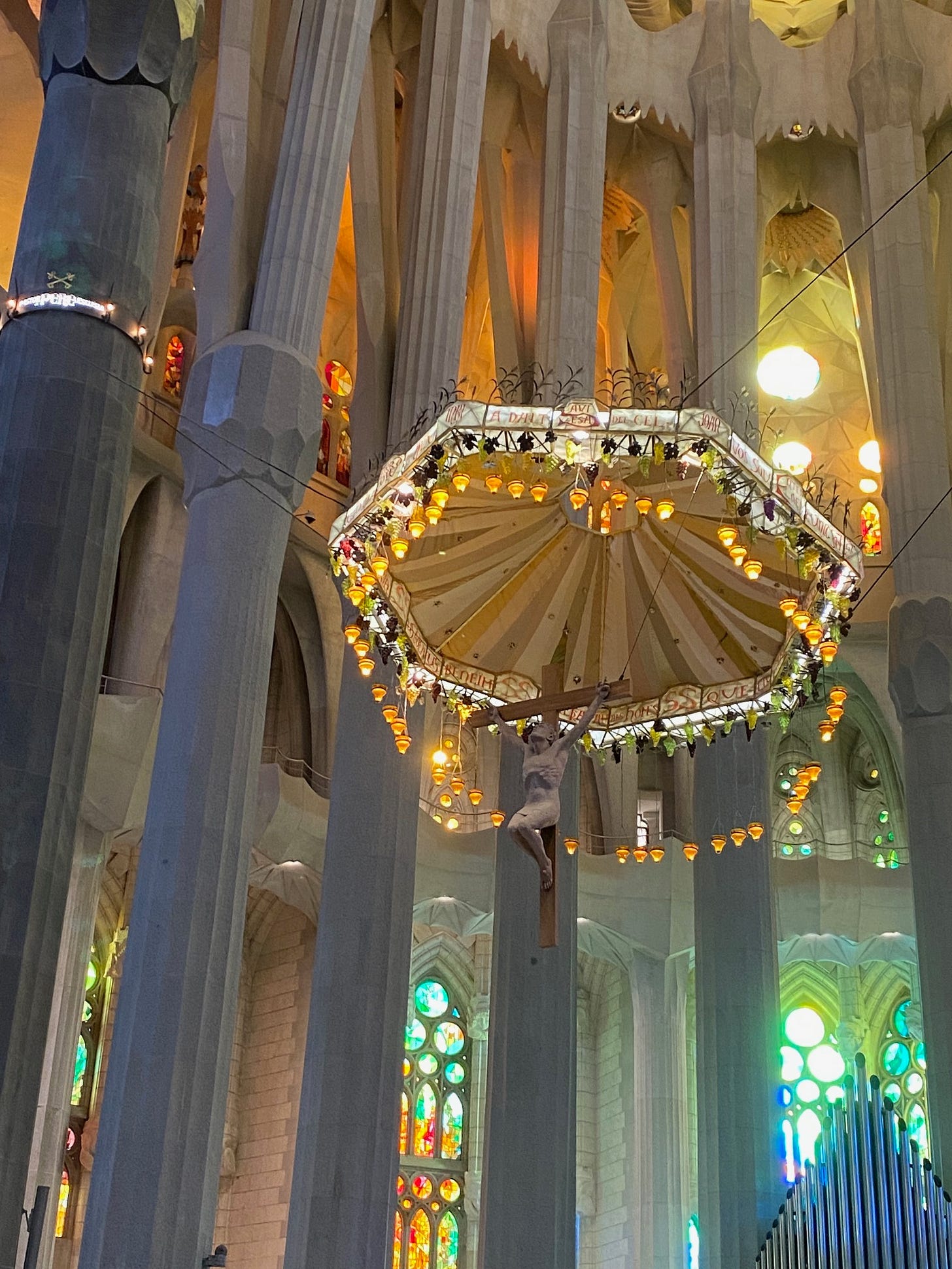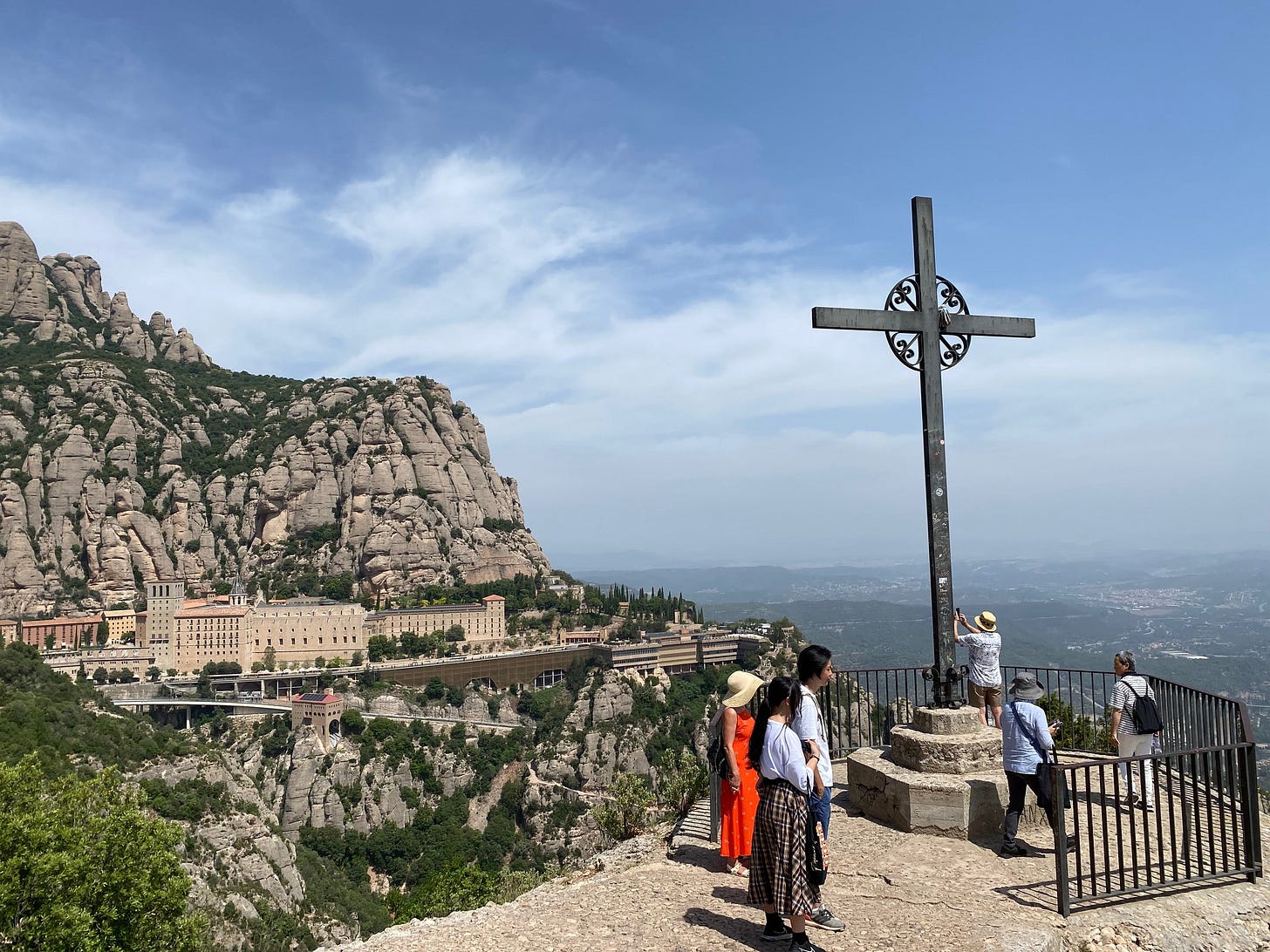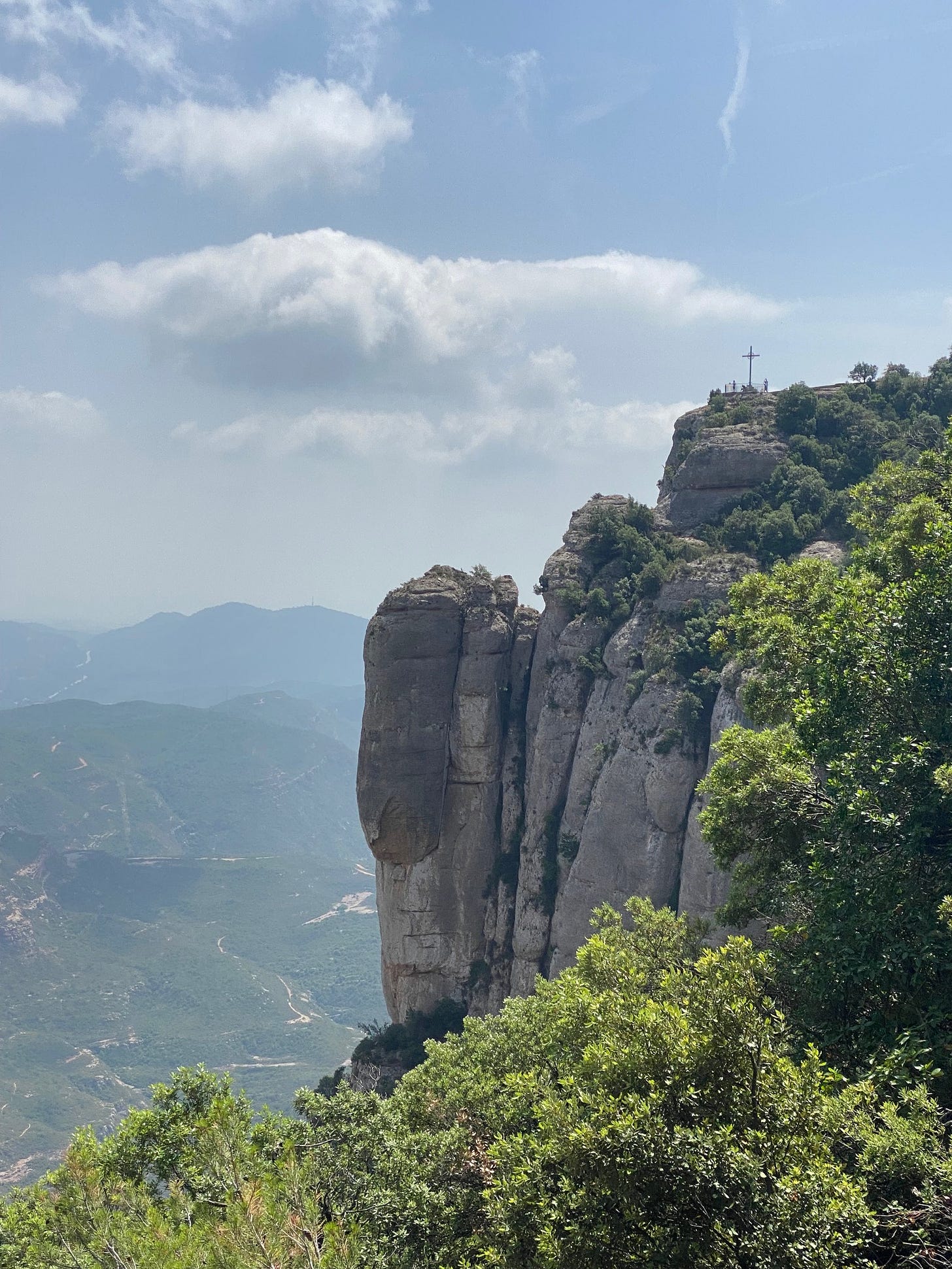For the past several days, my partner Anthony and I have been vacationing in Barcelona, Spain (it’s why my note is a day late, I apologize). The trip so far hasn’t been a vacation of the relaxing sort: I keep dragging him to churches and he keeps forcing me to eat tapas. After almost a week, I’m a little patatas bravas-ed and pan con tomate-ed out, the way I think he’s a little churched out. I’m not exactly a foodie, and he’s not exactly religious.
After dragging him to Barcelona’s Cathedral, the Church of the Sacred Heart on Mount Tibidabo, the Santa Maria del Mar in El Born, the monastery at Montserrat, and the Sagarada Familia, when our Rick Steves guidebook suggested the Basílica de la Puríssima Concepció (Church of the Holy Conception) on our self-guided walking tour of the Eixample District, Anthony politely demurred. “I don’t really need to go to another church.”
What always strikes me about the ornate gothic and neogothic churches of Europe is how different they are from the churches I grew up with in West Virginia. The small Methodist churches of Appalachia are as plain as the Catholic cathedrals and basilicas of Europe are lavish and gilded; I suppose partly out of principle and partly out of poverty.
The first time I ever stepped foot in a Catholic church was in Bavaria, when I was an exchange student in high school nearly twenty years ago. Far from awestruck, I was offended. The small village church’s interior was covered in detailed artwork as a golden crucifix hung over a baroque altar (at least that’s how I remember it). My populist, American Protestant sensibilities saw this as a waste. The money spent on decorating this church could have been put to better use helping the poor, I thought.
I had a much different reaction this time around. Admittedly, both Anthony and I were both a little churched out by the time we were standing in line for Antoni Gaudí’s still-unfinished masterpiece, the Sagrada Familia, on Friday evening. When we finally got in, however, we were floored. The photos I had seen of the church’s interior don’t do it justice. The setting sun shone through the beautiful stained glass, drenching the church’s art-nouveau and neo-gothic nave in radiant orange, yellow, and red light.
What was most striking to me, however, was the massive, expressionist crucifix hanging over the altar by the Catalan sculptor Francesc Fajula. Fajula’s Christ, suspended to appear miraculously floating under the baldachin (altar canopy), shows Jesus in a moment of agony on the cross, stomach inhaled, rib cage exposed, knees bent up in excruciating pain, freezing in time one single moment during his brutal execution. Moved, I did something my younger Methodist self would have found anathema: I bought a replica of that crucifix to take home. It’s the first crucifix I’ve ever owned.
I felt a similar sense of wonder and connection a few days earlier when we visited the monastery at Montserrat. An hour’s train ride from Barcelona, Montserrat is an astounding, multi-peaked mountain range that towers over Catalonia’s coastal plain. For the past thousand years, a Benedictian abbey has called the side of one of the jagged peaks home. A cable car takes pilgrims and tourists alike up the hillside to visit the church, which was consecrated as a minor basilica by Pope Leo XIII in 1881.
After making our way through the church, Anthony suggested a short 20 minute hike out one of the rocky ridges to the Creu de Sant Miquel. The small cross stands on a steep ridge that juts out away from the monastery, providing sweeping views of the monastery and the valley below. They say on a clear day you can see all the way to the Mediterranean Sea.
As we stood there, looking at the simple, metal cross with the Santa Maria de Montserrat abbey behind it, and the sweeping valley below us, I couldn’t help but feel connected to God. And I couldn’t separate that feeling from the Cross, and what I saw in that crucifix: this isn’t just a fleeting feeling of connection. The Cross is a call to action.
Now, it may be shocking to hear a Progressive Christian like me venerate the Cross or a crucifix in any way. Some progressives have attacked the Cross as a symbol of our religion and called for us to stop using it. Because it was carried by “Christian” warriors and merchants massacring innocents both in the Crusades and into the Western Hemisphere, some see it as a symbol of genocide and colonialism. Others see it as a symbol of oppression, whose oppressors have told them they must patiently suffer their oppression as Christ patiently suffered for us.
All of these are fair, important, and necessary critiques.
I wish to take nothing away from them. I can definitely see and respect the point that they are making. But I wanted to offer this week my take on the Cross, what it means to me.
First, like most Progressive Christians, I completely reject the idea that Jesus suffered and died for our sins because God demands that sin be punished. That’s an idea that has its roots in medieval thinking, and makes little sense to modern thinkers. (For you theology nerds, this is called substitutionary atonement, and while justification for it can be found in the New Testament, it’s only been mainstream for about the last thousand years. You can read more about it in my explainer about atonement theology.)
For me, when I see a Cross, or when I see Jesus’ suffering on a crucifix, I see what a dangerous and powerful and idea Love can be. Here was a prophet, a healer, who proclaimed a message of non-violence, a message of love for God and neighbor, a message that the current way things are going aren’t the way they should be going. And he called on the people around him to take up this cause, this cause of Radical Love—a message so powerful and astounding that we’re still talking about it today.
But that message was—and is—dangerous to the status quo. So dangerous to the current order that the Empire executed him for spreading it. They would not just execute him, but execute him in the most horrific, degrading way possible. Death by crucifixion was anything but fast. Truly evil, it was meant to prolong suffering. Death by crucifixion could take anywhere from three to four hours to three or four days.
The keepers of the current order wanted to send a message: this sort of behavior, this sort of Radical Love, is unacceptable. Step out of line—by turning over tables in the temple while calling out injustice, oppression, and hypocrisy—and you will be punished.
But a funny thing happened. Jesus’ message didn’t die, it only gained steam. The simple, poor Palestinian who preached a message of Love didn’t fade away, he only became more famous, and his following only grew—by the billions.
When I see the Cross, I see a call to action.
For me, it’s a reminder to do the only thing God has commanded us to do in this lifetime: to Love. It’s a reminder that God has called us to radically re-center our lives around loving God and loving God’s creation, our neighbors and ourselves. To live our lives as Christians, radically re-centering our lives on Love, we too must do as Jesus did. We must turn the other cheek, but we must also call out injustice and hypocrisy, dedicating our lives to ending systems of oppression and systems that justify poverty.
It’s also a reminder that this could get us killed, just as it killed Christ. The status quo—the people in power, the oppressors—don’t like it when you’re not quiet. They don’t like their hypocrisy called out. They want their money-changing tables to remain upright in the Holy Cathedral of Capitalism, growing quarter after quarter, while the rest of us live paycheck to paycheck, struggling to feed our families, struggling to pay for insulin, struggling to maybe retire one day, in the richest country in the history of the world.
It’s that struggle that continues, and it's that struggle I see when I see a Cross or Crucifix. But here’s the Good News: God is on our side.
With Love,
Andrew
Barcelona, Spain
July 17, 2023








“It’s also a reminder that this could get us killed, just as it killed Christ.”
I’ve read the command to Love many, many times, but I’ve rarely heard the ‘reminder’ that this could get us killed, that following the Christ-in-Jesus can mean following him to death, as Bonhoeffer did.
If you have not already, I suggest you find an opportunity to read “The Last Week” by John Dominic Crosson and Marcus Borg. It strengthened my conviction that Christ was a revolutionary killed by the civil and religious powers because he threatened the system. That and John 21:15-17.